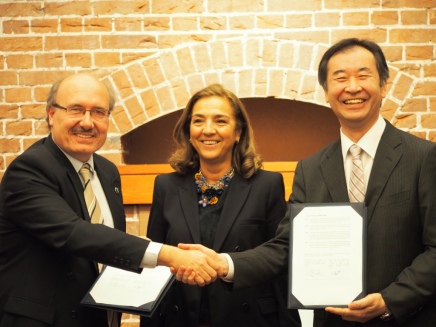Spain and Japan agree on the installation of four new telescopes on the island of La Palma

On April 13th, the acting Secretary of State for R+D+i, Carmen Vela, presided, together with the Japanese Deputy Minister of Education, Culture, Sport, Science and Technology, Tsutomu Tomioka, over the signing of the collaborative agreement for the installation and operation of four Cherenkov telescopes at the Roque de los Muchachos Observatory on the Island of La Palma. The agreement was signed in Tokyo by Rafael Rebolo, Director of the Instituto de Astrofísica de Canarias (IAC) and Takaaki Kajita, Director of the Institute for Cosmic Ray Research (ICRR) of the University of Tokyo.
mineco
The four Cherenkov telescopes, 23 metres in diameter, known as Large Size Telescopes (LST) will permit the observation of high energy gamma rays, and of phenomena associated with dark matter. These telescopes would be the biggest in the CTA-North Observatory, which Spain may host in La Palma, and as a group they would then form the central part of its infrastructure, around which a further 15 telescopes called MST (Medium Size Telescopes), each 12 metres in diameter, would be installed.
The LST telescopes have been designed by researchers and technologists from international universities and research centres (Japan, Iataly, France, Germany, Brazil, India, Sweden and Croatia) in collaboration with Spanish research groups of the University of Barcelona, Instituto de Física de Altas Energías de Barcelona (IFAE), Centro de Investigaciones Energéticas, Medioambientales y Tecnológicas (CIEMAT), Universidad Complutense de Madrid, Universidad Autónoma de Barcelona, Instituto de Ciencias del Espacio (IEEC-CSIC), Universidad de Jaén and the Instituto de Astrofísica de Canarias.
IEEC participation
This agreement will be a major step for researchers of the IEEC which form part of the consortium. IEEC has a relevant presence within the consortium CTA and has several research groups that have been founding members of the project.
On the one hand, the group of the Institute of Space Sciences (IEEC-CSIC) led by ICREA research professor and director of the unit, Diego F. Torres and the Ramon y Cajal researcher Emma de Oña Wilhelmi, acted as scientific director and is responsible for developing one of the major software modules which control the observatory.
On the other, the group of the Institute of Cosmos Sciences (IEEC-UB), led by theprofessor and scientific director of ICCUB, Josep Maria Paredes and the aggregate professor Marc Ribo, has participated in the scientific objectives definition and are involved in the design and production microelectronics for CTA cameras.
Finally, the group of the Centre for Studies and Space Research (IEEC-UAB) led by Lluís Font, professor in the Department of Physics at UAB and Markus Gaug, postdoctoral researcher, coordinates the group of central calibration facilities, including calibration the individual telescopes, network of telescopes, the atmosphere, and of the precision in pointing to the sources; and participates together with the Institute for High Energy Physics (IFAE) in the development of advanced instrumentation for the characterization of the atmosphere.
telescopis_1
Artistic representation of four giant telescopes proposed by CTA. Credit: IFAE, CTA Consortium
About CTA
The CTA consortium is made up by over 1,200 scientists working in 200 research centres in 32 countries. Spain and Japan are the two major contributors to CTA-North. The objective of the consortium is to build a telescopic array for the detection of extremely high energy gamma rays which yield information about the most violent extreme events occurring in the universe.
The Ministry of Economy and Competitivity has added its major financial effort to those of other international and national entities to bring the CTA-North to Spain, providing a fund of 40 million euros, which is half the total construction cost.
The CTA is formed by two observatories, one in the northern and the other in the southern hemisphere. The total array will be made up of 120 telescopes, distributed between the two. The CTA-North observatory will be sited at the Roque de los Muchachos Observatory on the Island of La Palma, while CTA-South will be at the Observatory of the European Southern Observatory (ESO), at Cerro Paranal (Chile).
